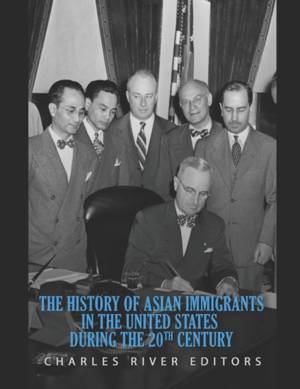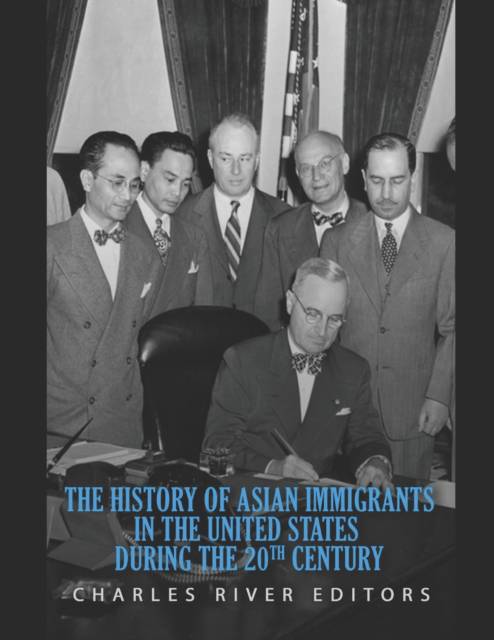
- Afhalen na 1 uur in een winkel met voorraad
- Gratis thuislevering in België vanaf € 30
- Ruim aanbod met 7 miljoen producten
- Afhalen na 1 uur in een winkel met voorraad
- Gratis thuislevering in België vanaf € 30
- Ruim aanbod met 7 miljoen producten
Zoeken
The History of Asian Immigrants in the United States during the 20th Century
Charles River
Paperback | Engels
€ 11,45
+ 22 punten
Uitvoering
Omschrijving
The story of early Asian immigration to the United States is also one about race legislation and discrimination at a time when global populations were moving with more frequency and merging ahead of their ability to practically assimilate. The greatest involuntary migration in history took place as some 12.5 million black African crossed the Atlantic as slaves.[1] In the New World, the advent of abolition created a knock-on labor crisis that was filled in many instances by contract or indentured labor from India and China while at the same time opportunist migration was taking place from the old cultures of Asia and Europe to the New World and the emerging European colonies.
Chinese immigration of a large scale did not begin until the 1850s when they began arriving by the thousands. The general record of US immigration suggests that this wave of incoming Chinese occurred pursuant to the California Gold Rush of 1849, and although this is certainly true, many other factors also contributed. Most Chinese immigrants of the mid-nineteenth and early twentieth century originated from the Guangdong Province of southern China and particularly its capital city of Guangzhou, then known as Canton. Although it is one of the most prosperous and industrialized provinces of modern China, in the nineteenth century it was poverty-stricken thanks in part to a succession of natural disasters, plagues and a declining dynasty. As was the case in many parts of the world, the introduction of New World crops like corn and potatoes prompted a rapid spike in population that was not matched by opportunity or economic growth. Land shortages followed which in turn brought about an intensification of urban poverty followed by long periods of civil unrest and political paralysis.
Initially Chinese migrants to California were regarded, and often regarded themselves, as a sojourner, in other words intending to remain out of China only long enough to earn the money to buy land or establish a business in China, at which point they would return. It was traditional in Chinese culture at the time for wives and daughters to remain behind to take care of family and property while men migrated to work. As a consequence, the vast majority of incoming Chinese into California during this period were single men of working age.
Chinese immigration of a large scale did not begin until the 1850s when they began arriving by the thousands. The general record of US immigration suggests that this wave of incoming Chinese occurred pursuant to the California Gold Rush of 1849, and although this is certainly true, many other factors also contributed. Most Chinese immigrants of the mid-nineteenth and early twentieth century originated from the Guangdong Province of southern China and particularly its capital city of Guangzhou, then known as Canton. Although it is one of the most prosperous and industrialized provinces of modern China, in the nineteenth century it was poverty-stricken thanks in part to a succession of natural disasters, plagues and a declining dynasty. As was the case in many parts of the world, the introduction of New World crops like corn and potatoes prompted a rapid spike in population that was not matched by opportunity or economic growth. Land shortages followed which in turn brought about an intensification of urban poverty followed by long periods of civil unrest and political paralysis.
Initially Chinese migrants to California were regarded, and often regarded themselves, as a sojourner, in other words intending to remain out of China only long enough to earn the money to buy land or establish a business in China, at which point they would return. It was traditional in Chinese culture at the time for wives and daughters to remain behind to take care of family and property while men migrated to work. As a consequence, the vast majority of incoming Chinese into California during this period were single men of working age.
Specificaties
Betrokkenen
- Auteur(s):
- Uitgeverij:
Inhoud
- Aantal bladzijden:
- 52
- Taal:
- Engels
Eigenschappen
- Productcode (EAN):
- 9798519658706
- Verschijningsdatum:
- 12/06/2021
- Uitvoering:
- Paperback
- Formaat:
- Trade paperback (VS)
- Afmetingen:
- 216 mm x 279 mm
- Gewicht:
- 145 g

Alleen bij Standaard Boekhandel
+ 22 punten op je klantenkaart van Standaard Boekhandel
Beoordelingen
We publiceren alleen reviews die voldoen aan de voorwaarden voor reviews. Bekijk onze voorwaarden voor reviews.











